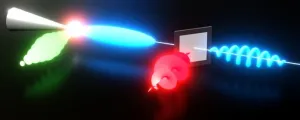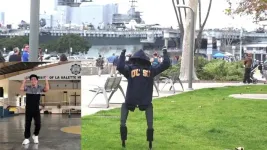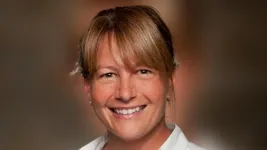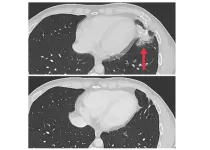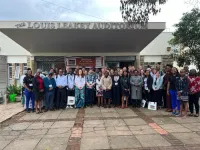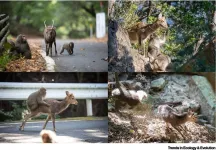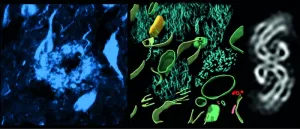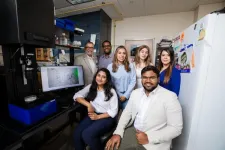(Press-News.org) Have you ever placed the palm of your left hand on the back of your right hand, in such a way that all fingers point in the same direction? If you have, then you probably know that your left thumb will not touch its right counterpart. Neither rotations nor translations nor their combinations can turn a left hand into a right hand and vice versa. This feature is called chirality.
Scientists at the University of Konstanz have now succeeded to imprint such a three-dimensional chirality onto the wave function of a single electron. They used laser light to shape the electron’s matter wave into left-handed or right-handed coils of mass and charge. Such engineered elementary particles with chiral geometries other than their intrinsic spin have implications for fundamental physics but may also be useful for a range of applications, such as quantum optics, particle physics or electron microscopy. "We are opening up new potentials for scientific research that have not been considered before," says Peter Baum, corresponding author of the study and head of the Light and Matter research group at the University of Konstanz.
Chirality of single particles and composites
Chiral objects play a crucial role in nature and technology. In the realm of elementary particles, one of the most important chiral phenomena is spin, which is often compared to a self-rotation of a particle, but is in fact a purely quantum-mechanical property with no classical analogue. An electron, for example, has a spin of one-half and therefore often exists in two potential states: a right-handed and a left-handed one. This fundamental aspect of quantum mechanics gives rise to many important real-world phenomena like almost all magnetic phenomena or the periodic table of the elements. Electron spin is also critical to the development of advanced technologies such as quantum computers or superconductors.
However, there are also composite chiral objects in which none of the constituents is chiral by itself. Our hand, for example, is composed of atoms with no particular chirality, but it is nevertheless a chiral object, as we have learned earlier. The same is true for many molecules in which chirality appears without the need for any chiral constituent. Whether a molecule is in the left-handed or in the right-handed geometry can make the differences between a healing drug and a harmful substance – both versions can have very different biological effects due to their different three-dimensional geometry. In materials science and nanophotonics, chirality influences the behavior of magnetic materials and metamaterials, leading to phenomena such as topological insulators or chiral dichroism. The ability to control and manipulate the chirality of composite materials composed of achiral constituents thus offers a rich knob to tune the properties of materials as required for applications.
How to induce geometrical chirality into a single electron
Is it possible to shape a single electron into a chiral three-dimensional object in terms of charge and mass? In other words: Can chirality be induced into an electron without the need for spin? So far, researchers have only moved electrons along spiral trajectories or created electron vortex beams in which the phase of the de Broglie wave rotates around the center of the beam at constant charge and mass. In contrast, the chiral matter wave object that the Konstanz physicists report in their Science paper has a flat de Broglie wave but the expectation values of charge and mass are shaped into a chiral form.
To create this object, they used an ultrafast transmission electron microscope and combined it with laser technology. The researchers first generated femtosecond electron pulses and then shaped them into chiral patterns by interacting with precisely modulated laser waves with spiral electric fields. Normally, electrons and laser photons do not interact in such an experiment, because energy and momentum cannot be conserved. However, silicon nitride membranes, which are transparent to the electrons but change the phase of the laser light, facilitated the interaction in the experiment.
The spiral electric fields in the laser wave either accelerated or decelerated the incoming electron around the center of the beam, depending on azimuthal position. Later in the beam, the accelerated or decelerated electrons eventually caught up with each other, and the wave function was transformed into a chiral coil of mass and charge. “We then used attosecond electron microscopy to obtain a detailed tomographic measurement of the electron’s expectation value, that is, the probability of being somewhere in space and time,” says Baum, explaining the way with which they measured the generated shapes. Right- or left-handed single or double coils appeared in the experiment. Neither spin nor angular momentum nor spiral trajectories were needed to produce this purely geometrical chirality.
To investigate whether an interaction of three-dimensional electron coils with other chiral materials would preserve chirality, the researchers put gold nanoparticles with chiral electromagnetic fields into their electron microscope and used the chiral electron coils to measure the scattering dynamics. Depending on whether the researchers fired a left-handed electron at a right-handed nanophotonic object or the other way round, the results showed constructive or destructive rotational interference phenomena. In a sense, the overall chirality never disappeared.
A whole new world of possibilities
The ability to shape electrons into chiral coils of mass and charge opens new avenues for scientific exploration and technological innovation. For example, the engineered chiral electron beams should be useful for chiral electron-optical tweezers, chiral sensor technologies, quantum electron microscopy or for probing and creating rotational motion in atomic or nanostructured materials. In addition, they will contribute to general particle physics and quantum optics.
“Although we have so far only modulated the electron, one of the simplest elementary particles, the method is general and applicable to almost any particle or matter wave. What other elementary particles have or can have such chiral shapes, and are there possible cosmological consequences?” says Baum. The researchers’ next step is to use their chiral electrons in attosecond electron imaging and two-electron microscopy, in order to further elucidate the intricate interplay between chiral light and chiral matter waves for applications in future technologies.
Key facts:
EMBARGOED UNTIL THURSDAY, 11 JULY 2024, 20:00 CEST (19:00 LONDON TIME, 14:00 U.S. EASTERN TIME)
Original publication: Y. Fang, J. Kuttruff, D. Nabben, P. Baum (2024) Structured electrons with chiral mass and charge. Science; doi: 10.1126/science.adp9143
Konstanz physicists have discovered a way to imprint a previously unseen geometrical form of chirality onto electrons.
Prof. Peter Baum leads the Light and Matter Research Group at the Department of Physics at the University of Konstanz. His team was recently awarded the Helmholtz Prize for Fundamental Research for the development of an innovative attosecond microscopy technique.
Funding: German Research Foundation (DFG; SFB 1432) and Dr. K. H. Eberle Foundation
Note to editors:
You can download photos here:
Link: https://www.uni-konstanz.de/fileadmin/pi/fileserver/2024/structured_electrons_figure1.jpg
Caption: Schematic representation of the experimental setup used to shape electrons into chiral coils of mass and charge
Copyright: Dr. Yiqi Fang, University of Konstanz
Link: https://www.uni-konstanz.de/fileadmin/pi/fileserver/2024/structured_electrons_figure2.jpg
Caption: Measurement of chiral matter waves
Copyright: Dr. Yiqi Fang, University of Konstanz
END
Structured electrons with chiral mass and charge
Physicists in Konstanz (Germany) have discovered a way to imprint a previously unseen geometrical form of chirality onto electrons. The electrons are shaped into chiral coils of mass and charge
2024-07-11
ELSE PRESS RELEASES FROM THIS DATE:
Learning dance moves could help humanoid robots work better with humans
2024-07-11
Engineers at the University of California San Diego have trained a humanoid robot to effortlessly learn and perform a variety of expressive movements, including simple dance routines and gestures like waving, high-fiving and hugging, all while maintaining a steady gait on diverse terrains.
The enhanced expressiveness and agility of this humanoid robot pave the way for improving human-robot interactions in settings such as factory assembly lines, hospitals and homes, where robots could safely operate alongside humans or even replace them in hazardous environments like laboratories or disaster sites.
“Through expressive and more human-like ...
Women and social exclusion: The complicated nature of rejection and retaliation
2024-07-11
New research from the University of Ottawa (uOttawa) has provided a complicated glance into young women’s responses to interpersonal conflict, with retaliation often the answer to rejection and perceived social exclusion by other females.
The study, published in Nature’s Scientific Reports, highlights the complicated nature of women’s interpersonal relationships by examining the stress arising from rejection, and if the personal characteristics of those imposing the rejection influences ...
Immunotherapy approach shows potential in some people with metastatic solid tumors
2024-07-11
Early findings from a small clinical trial provide evidence that a new cellular immunotherapy approach may be effective in treating metastatic solid tumors. In the trial, researchers from the National Institutes of Health (NIH) genetically engineered normal white blood cells, known as lymphocytes, from each patient to produce receptors that recognize and attack their specific cancer cells. These initial findings are from people with metastatic colorectal cancer who had already undergone multiple earlier treatments. The personalized immunotherapy shrank tumors in several patients and was able to keep the tumors from regrowing for up to seven months. ...
Neighborhood impact on children's well-being shifted during COVID-19 pandemic, ECHO study suggests
2024-07-11
The COVID-19 pandemic significantly disrupted daily life and has raised concerns about its impact on children’s well-being. A new study from the NIH Environmental influences on Child Health Outcomes Program (ECHO) sheds light on how a neighborhood’s physical and social environment influenced a child’s well-being before and during the pandemic.
According to an analysis of ECHO Cohort data, the neighborhood environment was less likely to be associated with child well-being during the ...
Neurobiologist Sung Soo Kim receives 2024 Scholar Award from McKnight Foundation
2024-07-11
(Santa Barbara, Calif.) — Birds migrating. Your cat, returning home from a day of roaming. Bees taking pollen to their hives. You, finding yourself back home without actually remembering the drive from work. Animal navigation is a fundamental behavior, so innate that most of the time we don’t notice that we’re doing it. And yet, so many times a day we (and the animals around us) unerringly find our ways to our target locations whether they be old haunts or new venues, from different directions and even in the dark.
How do we do it? That’s the question UC Santa Barbara neurobiologist Sung Soo Kim seeks to ...
Charting an equitable future for DNA and ancient DNA research in Africa
2024-07-11
CLEVELAND AND NAIROBI — July 11, 2024 — Today, the American Journal of Human Genetics published a perspective piece on the need for an equitable and inclusive future for DNA and ancient DNA (aDNA) research in Africa. The paper, coauthored by an international team of 36 scientists from Africa, North America, Asia, Australia, and Europe, was led by Dr. Elizabeth (Ebeth) Sawchuk of the Cleveland Museum of Natural History and Dr. Kendra Sirak of Harvard University.
DNA from ancient and living African peoples is critical for researchers studying our species’ evolution and population ...
Introducing co-cultures: When co-habiting animal species share culture
2024-07-11
Cooperative hunting, resource sharing, and using the same signals to communicate the same information—these are all examples of cultural sharing that have been observed between distinct animal species. In an opinion piece published June 19 in the journal Trends in Ecology & Evolution, researchers introduce the term “co-culture” to describe cultural sharing between animal species. These relationships are mutual and go beyond one species watching and mimicking another species’ behavior—in co-cultures, both species influence each other in substantial ways.
“Co-culture challenges the notion ...
Study finds health risks in switching ships from diesel to ammonia fuel
2024-07-11
As container ships the size of city blocks cross the oceans to deliver cargo, their huge diesel engines emit large quantities of air pollutants that drive climate change and have human health impacts. It has been estimated that maritime shipping accounts for almost 3 percent of global carbon dioxide emissions and the industry’s negative impacts on air quality cause about 100,000 premature deaths each year.
Decarbonizing shipping to reduce these detrimental effects is a goal of the International Maritime Organization, ...
Seeing inside Alzheimer’s disease brain
2024-07-11
Scientists investigating Alzheimer’s disease have determined the structure of molecules within a human brain for the very first time.
Published today in Nature, the study describes how scientists used cryo-electron tomography, guided by fluorescence microscopy, to explore deep inside an Alzheimer’s disease donor brain.
This gave 3-dimensional maps in which they could observe proteins, the molecular building blocks of life a million-times smaller than a grain of rice, within the brain.
The study zoomed in on two proteins that cause dementia– ‘β-amyloid’, a protein that forms microscopic ...
Nanoplastics and ‘forever chemicals’ disrupt molecular structures, functionality
2024-07-11
EL PASO, Texas (July 11, 2024) – Researchers at The University of Texas at El Paso have made significant inroads in understanding how nanoplastics and per- and polyfluoroalkyl substances (PFAS) — commonly known as forever chemicals — disrupt biomolecular structure and function. The work shows that the compounds can alter proteins found in human breast milk and infant formulas — potentially causing developmental issues downstream.
Nanoplastics and forever chemicals are manmade compounds present throughout the environment; a series of recent studies have linked them to numerous ...
LAST 30 PRESS RELEASES:
Scientists discover a hidden RNA “aging clock” in human sperm
New quantum boundary discovered: Spin size determines how the Kondo effect behaves
Ancient ‘spaghetti’ in dogs’ hearts reveals surprising origins of heartworm
Full value added tax on meat: a first step towards pricing the environmental damages caused by diets
Hidden mpox exposure detected in healthy Nigerian adults, revealing under-recognized transmission
Shingles vaccine linked to slower biological aging in older adults
A self-assembling shortcut to better organic solar cells
A two-week leap in breeding: Antarctic penguins’ striking climate adaptation
Climate risks to insurance and reinsurance of global supply chains
58% of patients affected by 2022 mpox outbreak report lasting physical symptoms
Golden Gate method enables rapid, fully-synthetic engineering of therapeutically relevant bacteriophages
Polar weather on Jupiter and Saturn hints at the planets’ interior details
Socio-environmental movements: key global guardians of biodiversity amid rising violence
Global warming and CO2 emissions 56 million years ago resulted in massive forest fires and soil erosion
Hidden order in quantum chaos: the pseudogap
Exploring why adapting to the environment is more difficult as people age
Society for Laboratory Automation and Screening welcomes new scientific director: Madeline M. Farley, Ph.D.
Austrian cow shows first case of flexible, multi-purpose tool use in cattle
Human nasal passages defend against the common cold and help determine how sick we get
Research alert: Spreading drug costs over the year may ease financial burden for Medicare cancer patients
Hospital partnership improves follow up scans, decreases long term risk after aortic repair
Layered hydrogen silicane for safe, lightweight, and energy-efficient hydrogen carrier
Observing positronium beam as a quantum matter wave for the first time
IEEE study investigates the effects of pointing error on quantum key distribution systems
Analyzing submerged fault structures to predict future earthquakes in Türkiye
Quantum ‘alchemy’ made feasible with excitons
‘Revoice’ device gives stroke patients their voice back
USF-led study: AI helps reveal global surge in floating algae
New method predicts asthma attacks up to five years in advance
Researchers publish first ever structural engineering manual for bamboo
[Press-News.org] Structured electrons with chiral mass and chargePhysicists in Konstanz (Germany) have discovered a way to imprint a previously unseen geometrical form of chirality onto electrons. The electrons are shaped into chiral coils of mass and charge
